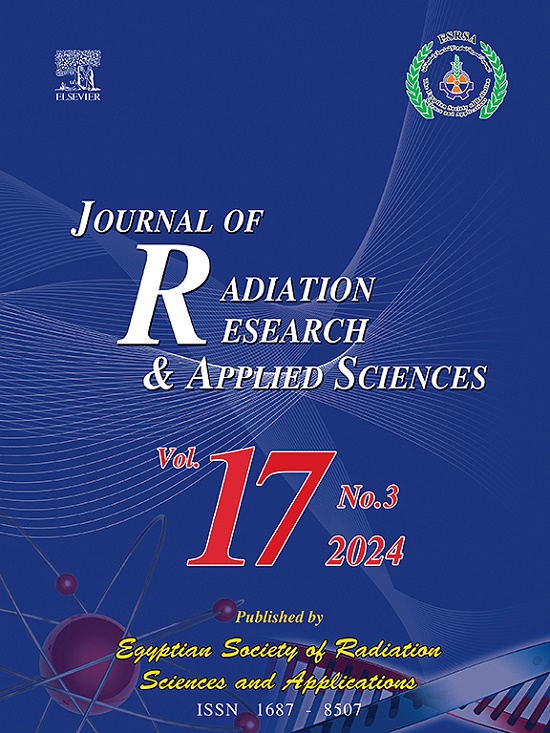黄芩苷对妊娠大鼠及胎鼠卵巢x射线及细菌脂多糖损伤中半乳糖凝集素-9-tim-3通路的影响
IF 1.7
4区 综合性期刊
Q2 MULTIDISCIPLINARY SCIENCES
Journal of Radiation Research and Applied Sciences
Pub Date : 2025-03-02
DOI:10.1016/j.jrras.2025.101390
引用次数: 0
摘要
妊娠期间暴露于x射线照射和细菌脂多糖(LPS)诱导的感染可通过增加氧化应激、免疫衰竭和炎症损害母体和胎儿健康。半乳糖凝集素-9- tim -3信号通路在免疫调节和炎症中起着至关重要的作用,特别是在组织损伤和应激过程中。黄芩苷(BC)是一种黄酮类化合物,以其抗氧化和抗炎特性而闻名,已显示出保护组织免受损伤的潜力。本研究旨在探讨BC对x射线照射和LPS暴露下妊娠大鼠卵巢损伤及半乳糖凝集素-9- tim -3通路的影响。材料与方法48只妊娠sd - dawley大鼠随机分为8组,每组6只,分别为对照组、单纯BC组、x射线照射组、LPS组、x射线+ LPS组、x射线+ BC组、LPS + BC组、x射线+ LPS + BC组。检测各组胎儿特征(长、高、流产/吸收)、卵巢组织病理及免疫组织学检查参数、氧化应激标志物(MDA、SOD、GPx水平)、Tim-3、Galectin-9表达水平。进一步,我们评估了Tim-3在CD4+和CD8+ T细胞上的表达与Galectin-9免疫反应评分(IRS)的相关性,以评估Galectin-9-Tim-3通路。结果病理分析显示,x线和LPS暴露增加卵巢变性和纤维化评分。然而,BC治疗保留了暴露组(x射线和/或LPS)卵巢组织的完整性。在暴露于x射线和/或LPS的大鼠中,BC治疗显著改善了胎儿结局,包括体重和长度增加,以及流产率降低。半凝集素-9 IRS与Tim-3的表达有很强的相关性。BC治疗降低了半乳糖凝集素-9和Tim-3的表达,表明这一途径受到调节。结论bc对x射线照射和/或LPS感染妊娠大鼠的氧化应激、免疫失调和组织损伤具有保护和治疗作用。这些结果强调了它作为一种治疗选择的潜力,可以减少由环境和炎症应激源引起的妊娠并发症。需要进一步的临床研究来评估其在人体中的有效性和安全性。本文章由计算机程序翻译,如有差异,请以英文原文为准。
Effects of Baicalin on the Galectin-9-tim-3 pathway in ovarian damage induced by X-ray irradiation and bacterial lipopolysaccharide in pregnant rats and their fetuses
Introduction
Exposure to X-ray irradiation and bacterial lipopolysaccharide (LPS)-induced infection during pregnancy can harm both maternal and fetal health by increasing oxidative stress, immune exhaustion, and inflammation. The Galectin-9-Tim-3 signaling pathway plays a crucial role in immune regulation and inflammation, particularly during tissue injury and stress. Baicalin (BC), a flavonoid known for its antioxidant and anti-inflammatory properties, has shown potential in protecting against tissue damage. This study aims to investigate the effects of BC on ovarian damage and the Galectin-9-Tim-3 pathway in pregnant rats subjected to X-ray irradiation and LPS exposure.
Materials and methods
Forty-eight pregnant Sprague-Dawley rats were divided randomly into eight groups, each consisting of six rats, including control group, BC-only group, X-ray irradiation group, LPS group, X-ray + LPS group, X-ray + BC group, LPS + BC group, and X-ray + LPS + BC group. Fetal characteristics (length, height, and abortion/resorption), as well as pathological and immunohistological examination parameters of ovarian tissue, oxidative stress markers (MDA, SOD, and GPx levels), and the expression levels of Tim-3 and Galectin-9, were evaluated in each group. Furthermore, the correlation between Tim-3 expression on CD4+ and CD8+ T cells and the Galectin-9 immunoreactive score (IRS) was assessed to evaluate the Galectin-9-Tim-3 pathway.
Results
Pathological analyses revealed that X-ray and LPS exposure increased ovarian degeneration and fibrosis scores. However, BC treatment preserved ovarian tissue integrity in the exposed groups (X-ray and/or LPS). BC treatment significantly improved fetal outcomes, including increased weight and length, as well as reduced abortion rates, in rats exposed to X-ray and/or LPS. A strong correlation was observed between the Galectin-9 IRS and Tim-3 expression. BC treatment decreased the expression of Galectin-9 and Tim-3, suggesting modulation of this pathway.
Conclusion
BC demonstrated protective and therapeutic effects against oxidative stress, immune dysregulation, and tissue damage in pregnant rats exposed to X-ray irradiation and/or LPS infection. These results emphasize its potential as a therapeutic option for reducing pregnancy complications caused by environmental and inflammatory stressors. Further clinical studies are needed to evaluate its efficacy and safety in humans.
求助全文
通过发布文献求助,成功后即可免费获取论文全文。
去求助
来源期刊

Journal of Radiation Research and Applied Sciences
MULTIDISCIPLINARY SCIENCES-
自引率
5.90%
发文量
130
审稿时长
16 weeks
期刊介绍:
Journal of Radiation Research and Applied Sciences provides a high quality medium for the publication of substantial, original and scientific and technological papers on the development and applications of nuclear, radiation and isotopes in biology, medicine, drugs, biochemistry, microbiology, agriculture, entomology, food technology, chemistry, physics, solid states, engineering, environmental and applied sciences.
 求助内容:
求助内容: 应助结果提醒方式:
应助结果提醒方式:


